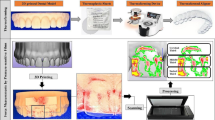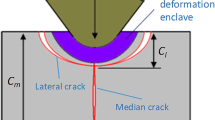Abstract
The paper aims to analyze the InfiniteFocus system for the capability to measure macrogeometry of tooth models manufactured using two material extrusion techniques, i.e. MEM and FFF, and analyze the accuracy of manufacturing the said models. To achieve the goals it was needed to carry out two studies. The first one focused on estimating the measurement error of the microscope in the course of digitalizing geometry with the use of a rotary table. The research involved samples of cylindrical and spherical geometries. In the result further measurements of tooth model in the second stage were decided to be performed using vertical resolution 10 µm and overlap 70 %. For these settings, the absolute values of the mean measurement error for the MEM and FFF samples were about 0.01 mm. From 95 % to 98 % of points measured for all the tooth models were contained in the assumed tolerance range of ±0.25 mm for dental models.
Similar content being viewed by others
References
M. A. Boboulos, CAD-CAM and Rapid Prototyping Application Evaluation, Boboulos, Ph.D. and Ventus Publishing (2010).
P. Rokicki et al., Rapid prototyping in manufacturing of core models of aircraft engine blades, Aircraft Engineering and Aerospace Technology: An International Journal, 86(4) (2014) 323–327.
H. Kim et al., Optimized design of a body-powered finger prosthesis using fingertip trajectories based on polar coordinate analysis, Journal of Mechanical Science and Technology, 34(1) (2020) 387–399.
P. Rokicki et al., Manufacturing of aircraft engine transmission gear with SLS(DMLS) method, Aircraft Engineering and Aerospace Technology: An International Journal, 88(3) (2016) 397–403.
V. Raja and J. Kiran, Reverse Engineering and Industrial Perspective, Springer-Verlag, London (2010).
R. J. Urbanc et al., A reverse engineering methodology for rotary components from point cloud data, The International Journal of Advanced Manufacturing Technology, 37(11) (2008) 1146–1167.
E. Bagci, Reverse engineering applications for recovery of broken or worn parts and remanufacturing: three case studies, Advanced in Engineering Software, 40(6) (2009) 407–418.
A. Kawalec and M. Magdziak, The selection of radius correction method in the case of coordinate measurements applicable for turbine blades, Precision Engineering, 49 (2017) 243–252.
M. Magdziak, The influence of a number of points on results of measurements of a turbin blade, Aircraft Engineering and Aerospace Technology: An International Journal, 89(6) (2017) 953–959.
I. Gibson et al., Rapid prototyping for architectural models, Rapid Prototyping Journal, 8(2) (2002) 91–95.
M. Van Eijnatten et al., Influence of CT parameters on STL model accuracy, Rapid Prototyping Journal, 23(4) (2017) 678–685.
G. Budzik and P. Turek, Improved accuracy of mandible geometry reconstruction at the stage of data processing and modeling, Australasian Physical and Engineering Sciences in Medicine, 41(3) (2018) 687–695.
M. Van Eijnatten et al., CT image segmentation methods for bone used in medical additive manufacturing, Medical Engineering and Physics, 51 (2018) 6–16.
S. Singare et al., Individually prefabricated prosthesis for maxilla reconstruction, Journal of Prosthodontics, 17(2) (2008) 135–140.
M. Kozakiewicz, Computer-aided orbital wall defects treatment by individual design ultrahigh molecular weight polyethylene implants, Journal of Cranio-Maxillofacial Surgery, 42(4) (2014) 283–289.
J. Faber et al., Rapid prototyping as a tool for diagnosis and treatment planning for maxillary canine impaction, American Journal of Orthodontics and Dentofacial Orthopedics, 129(4) (2006) 583–589.
S. Y. Kwon et al., Computer-aided designing and manufacturing of lingual fixed orthodontic appliance using 2d/3d registration software and rapid prototyping, International Journal of Dentistry (2014) 1–8.
S. Nam and B. Kim, Design of material removal rate to reduce machining time of dental crown, Journal of Mechanical Science and Technology, 33(7) (2019) 3423–3434.
B. Bidanda and P. J. Brtolo (Ed(s)), Virtual Prototyping and Bio Manufacturing in Medical Applications, Springer US (2008).
L. Zhou and Y. Liu, Rapid prototyping in correction of craniofacial skeletal deformities, Hoque, M.E. (Ed.), Advanced Applications of Rapid Prototyping Technology in Modern Engineering, IntechOpen, Rijeka (2011) 119–128.
M. Martorelli et al., A comparison between customized clear and removable orthodontic appliances manufactured using RP and CNC techniques, Dental Materials, 29(2) (2013) e1–e10.
A. Reyes et al., Accuracy of surgical guides made from conventional and a combination of digital scanning and rapid prototyping techniques, The Journal of Prosthetic Dentistry, 113(4) (2015) 295–303.
G. Budzik et al., Analysis of the accuracy of reconstructed two teeth models manufactured using the 3DP and FDM technologies, Strojnikivestnik — Journal of Mechanical Engineering, 62(1) (2016) 11–20.
A. Hazeveld et al., Accuracy and reproducibility of dental replica models reconstructed by different rapid prototyping techniques, American Journal of Orthodontics and Dentofacial Orthopedics, 145(1) (2014) 108–115.
W. N. W. Hassan et al., Comparison of reconstructed rapid prototyping models produced by 3-dimensional printing and conventional stone models with different degrees of crowding, American Journal of Orthodontics and Dentofacial Orthopedics, 151(1) (2017) 209–218.
M. Salmi et al., Rapid tooling method for soft customized removable oralappliances, The Open Dentistry Journal, 6(1) (2012) 85–89.
R. M. Gorguluarslan et al., Prediction assessment and validation of multiscale models for additively manufactured lattice structures under uncertainty, J. Mech. Sci. Technol., 33(3) (2019) 1365–1379.
M. Kumar, R. Ramakrishnan and A. Omarbekova, 3D printed polycarbonate reinforced acrylonitrile-butadiene-styrene composites: composition effects on mechanical properties, microstructure and void formation study, J. Mech. Sci. Technol., 33(3) (2019) 5219–5226.
J. Choi and S. Lee, Experimental validation of theoretical models for hypercube models made by fused deposition modelling technology, J. Mech. Sci. Technol., 33(3) (2019) 5951–5961.
N. Vorkapic et al., An additive manufacturing benchmark artifact and deviation measurement method, J. Mech. Sci. Technol, 34(7) (2020) 3015–3026.
G. B. Brown, Accuracy of 3-dimensional printed dental models reconstructedfrom digital intraoral impressions, American Journal of Orthodontics and Dentofacial Orthopedics, 154(5) (2018) 733–739.
K. Y. Lee et al., Accuracy of three-dimensional printing for manufacturing replica teeth, The Korean Journal of Orthodontics, 45(5) (2015) 217–225.
W. K. Saleh, Accuracy and reproducibility of linear measurements of resin, plaster, digital and printed study-models, Journal of Orthodontics, 42(4) (2015) 301–306.
T. Brajlih et al., Possibilities of using three-dimensional optical scanning in complex geometrical inspection, Strojnikivestnik — Journal of Mechanical Engineering, 57(11) (2011) 826–833.
J. S. Akmal et al., Cumulative inaccuracies in implementation of additive manufacturing through medical imaging, 3D thresholding and 3D modeling: a case study for an end-use implant, Applied Sciences, 10(8) (2020) 2968.
A. Nakasima et al., Three-dimensional computer-generated head model reconstructed from cephalograms, facial photographs, and dental cast models, American Journal of Orthodontics and Dentofacial Orthopedics, 127(3) (2005) 282–292.
A. A. Mäkitie et al., Three-dimensional printing for restoration of the donor face: a new digital technique tested and used in the first facial allotransplantation patient in finland, Journal of Plastic, Reconstructive and Aesthetic Surgery, 69(12) (2016) 1648–1652.
E. Taneva et al., 3D scanning, imaging, and printing in orthodontics, Issues in Contemporary Orthodontics, 148 (2015).
B. R. Barbero and E. S. Ureta, Comparative study of different digitization techniques and their accuracy, Computer-Aided Design, 43(2) (2011) 188–206.
P. Turek and M. Magdziak, The influence of the type of a filter on the results of non-contact measurements of the selected-free-form surface, Mechanik, 91(11) (2018) 992–994.
A. Ender and A. Mehl, Accuracy of complete-arch dental impressions: a new method of measuring trueness and precision, The Journal of Prosthetic Dentistry, 109(2) (2013) 121–128.
G. Moroni et al., Uncertainty in 3d micromeasurement with focus variation microscopy, Proceedings of the 4M/ICOMM2015 Conference (2015).
IFM Manual, Alicona (2011).
F. Helmli, Focus variation instruments, R. Leach (ed.), Optical Measurement of Surface Topography, Springer BerlinHeidelberg, Berlin (2011) 131–166.
R. Danzl et al., Focus variation a robust technology for high resolution optical 3D surface metrology, Strojnikivestnik — Journal of Mechanical Engineering, 57(3) (2011) 245–256.
F. Baruffi et al., On the application of replica molding technology for the indirect measurement of surface and geometry of micromilled components, Micromachines, 8(6) (2017) 195–1195–18.
M. Magdziak and R. Wdowik, Coordinate measurements of geometrically complex ceramic parts, Applied Mechanics and Materials, 627 (2014) 172–176.
Hanssen and J., Stratasys, Fortus 360mc/400mc Accuracy Study, https://pdf.directindustry.com, Accessed on 2020-02-04.
A. M. Ellison, Effect of seed dimorphism on the density-dependent dynamics of experimental populations of atriplextri-angularis (chenopodiaceae), American Journal of Botany, 74(8) (1987) 1280–1288.
R. Pfister et al., Good things peak in pairs: a note on the bi-modalitycoefficient, Frontiers in Psychology, 4 (2013) 83–97.
Author information
Authors and Affiliations
Corresponding author
Additional information
Recommended by Editor Hyung Wook Park
Anna Bazan completed her Ph.D. in Mechanical Engineering with a focus on the wear of single layer grinding wheels. Currently, she is an Assistant Professor in the Department of Manufacturing Techniques and Automation at Rzeszow University of Technology, Poland. She has 10 years of experience in teaching and research. Her research interests include metrology of geometric quantities, in particular the measurement and analysis of surface topography.
PawełTurek received the Ph.D. degree in Mechanical Engineering from Rzeszow University of Technology in 2017. He is currently an Assistant Professor in the Department of Manufacturing Techniques and Automation at Rzeszow University of Technology, Poland. His research aim is to increase the accuracy of the reconstruction and manufacturing anatomical models geometry. He is also interested in design of orthopedic devices and implants.
ŁukaszPrzeszłowski received the Ph.D. degree in Production Engineering from Rzeszow University of Technology in 2016. He is currently an Assistant Professor in the Department of Mechanical Engineering at Rzeszow University of Technology, Poland. His research interests include additive manufacturing, reverse engineering and CAD/CAM/CAE systems.
Rights and permissions
About this article
Cite this article
Bazan, A., Turek, P. & Przeszłowski, Ł. Assessment of InfiniteFocus system measurement errors in testing the accuracy of crown and tooth body model. J Mech Sci Technol 35, 1167–1176 (2021). https://doi.org/10.1007/s12206-021-0230-z
Received:
Revised:
Accepted:
Published:
Issue Date:
DOI: https://doi.org/10.1007/s12206-021-0230-z




